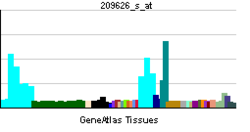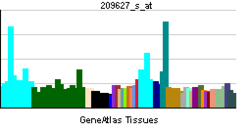- OSBPL3
-
Oxysterol binding protein-like 3 Identifiers Symbols OSBPL3; DKFZp667P1518; KIAA0704; MGC21526; ORP-3; ORP3; OSBP3 External IDs OMIM: 606732 MGI: 1918970 HomoloGene: 49422 GeneCards: OSBPL3 Gene Gene Ontology Molecular function • protein binding
• lipid bindingBiological process • transport
• lipid transportSources: Amigo / QuickGO RNA expression pattern 

More reference expression data Orthologs Species Human Mouse Entrez 26031 71720 Ensembl ENSG00000070882 ENSMUSG00000029822 UniProt Q9H4L5 n/a RefSeq (mRNA) NM_015550.2 NM_027881 RefSeq (protein) NP_056365.1 NP_082157 Location (UCSC) Chr 7:
24.84 – 25.02 MbChr 6:
50.24 – 50.41 MbPubMed search [1] [2] Oxysterol-binding protein-related protein 3 is a protein that in humans is encoded by the OSBPL3 gene.[1][2]
This gene encodes a member of the oxysterol-binding protein (OSBP) family, a group of intracellular lipid receptors. Most members contain an N-terminal pleckstrin homology domain and a highly conserved C-terminal OSBP-like sterol-binding domain. Several transcript variants encoding different isoforms have been identified.[2]
References
- ^ Ishikawa K, Nagase T, Suyama M, Miyajima N, Tanaka A, Kotani H, Nomura N, Ohara O (Dec 1998). "Prediction of the coding sequences of unidentified human genes. X. The complete sequences of 100 new cDNA clones from brain which can code for large proteins in vitro". DNA Res 5 (3): 169–76. doi:10.1093/dnares/5.3.169. PMID 9734811.
- ^ a b "Entrez Gene: OSBPL3 oxysterol binding protein-like 3". http://www.ncbi.nlm.nih.gov/sites/entrez?Db=gene&Cmd=ShowDetailView&TermToSearch=26031.
Further reading
- "Toward a complete human genome sequence.". Genome Res. 8 (11): 1097–108. 1999. doi:10.1101/gr.8.11.1097. PMID 9847074.
- Laitinen S, Olkkonen VM, Ehnholm C, Ikonen E (2000). "Family of human oxysterol binding protein (OSBP) homologues. A novel member implicated in brain sterol metabolism.". J. Lipid Res. 40 (12): 2204–11. PMID 10588946.
- Lehto M, Laitinen S, Chinetti G, et al. (2001). "The OSBP-related protein family in humans.". J. Lipid Res. 42 (8): 1203–13. PMID 11483621.
- Gregorio-King CC, Collier GR, McMillan JS, et al. (2001). "ORP-3, a human oxysterol-binding protein gene differentially expressed in hematopoietic cells.". Blood 98 (7): 2279–81. doi:10.1182/blood.V98.7.2279. PMID 11568019.
- Jaworski CJ, Moreira E, Li A, et al. (2002). "A family of 12 human genes containing oxysterol-binding domains.". Genomics 78 (3): 185–96. doi:10.1006/geno.2001.6663. PMID 11735225.
- Strausberg RL, Feingold EA, Grouse LH, et al. (2003). "Generation and initial analysis of more than 15,000 full-length human and mouse cDNA sequences.". Proc. Natl. Acad. Sci. U.S.A. 99 (26): 16899–903. doi:10.1073/pnas.242603899. PMC 139241. PMID 12477932. http://www.pubmedcentral.nih.gov/articlerender.fcgi?tool=pmcentrez&artid=139241.
- Collier FM, Gregorio-King CC, Apostolopoulos J, et al. (2003). "ORP3 splice variants and their expression in human tissues and hematopoietic cells.". DNA Cell Biol. 22 (1): 1–9. doi:10.1089/104454903321112442. PMID 12590732.
- Scherer SW, Cheung J, MacDonald JR, et al. (2003). "Human chromosome 7: DNA sequence and biology.". Science 300 (5620): 767–72. doi:10.1126/science.1083423. PMC 2882961. PMID 12690205. http://www.pubmedcentral.nih.gov/articlerender.fcgi?tool=pmcentrez&artid=2882961.
- Hillier LW, Fulton RS, Fulton LA, et al. (2003). "The DNA sequence of human chromosome 7.". Nature 424 (6945): 157–64. doi:10.1038/nature01782. PMID 12853948.
- Lehto M, Tienari J, Lehtonen S, et al. (2004). "Subfamily III of mammalian oxysterol-binding protein (OSBP) homologues: the expression and intracellular localization of ORP3, ORP6, and ORP7.". Cell Tissue Res. 315 (1): 39–57. doi:10.1007/s00441-003-0817-y. PMID 14593528.
- Jin J, Smith FD, Stark C, et al. (2004). "Proteomic, functional, and domain-based analysis of in vivo 14-3-3 binding proteins involved in cytoskeletal regulation and cellular organization.". Curr. Biol. 14 (16): 1436–50. doi:10.1016/j.cub.2004.07.051. PMID 15324660.
- Gerhard DS, Wagner L, Feingold EA, et al. (2004). "The status, quality, and expansion of the NIH full-length cDNA project: the Mammalian Gene Collection (MGC).". Genome Res. 14 (10B): 2121–7. doi:10.1101/gr.2596504. PMC 528928. PMID 15489334. http://www.pubmedcentral.nih.gov/articlerender.fcgi?tool=pmcentrez&artid=528928.
- Benzinger A, Muster N, Koch HB, et al. (2005). "Targeted proteomic analysis of 14-3-3 sigma, a p53 effector commonly silenced in cancer.". Mol. Cell Proteomics 4 (6): 785–95. doi:10.1074/mcp.M500021-MCP200. PMID 15778465.
- Lehto M, Hynynen R, Karjalainen K, et al. (2005). "Targeting of OSBP-related protein 3 (ORP3) to endoplasmic reticulum and plasma membrane is controlled by multiple determinants.". Exp. Cell Res. 310 (2): 445–62. doi:10.1016/j.yexcr.2005.08.003. PMID 16143324.
- Ewing RM, Chu P, Elisma F, et al. (2007). "Large-scale mapping of human protein-protein interactions by mass spectrometry.". Mol. Syst. Biol. 3 (1): 89. doi:10.1038/msb4100134. PMC 1847948. PMID 17353931. http://www.pubmedcentral.nih.gov/articlerender.fcgi?tool=pmcentrez&artid=1847948.
Categories:- Human proteins
- Chromosome 7 gene stubs
Wikimedia Foundation. 2010.
